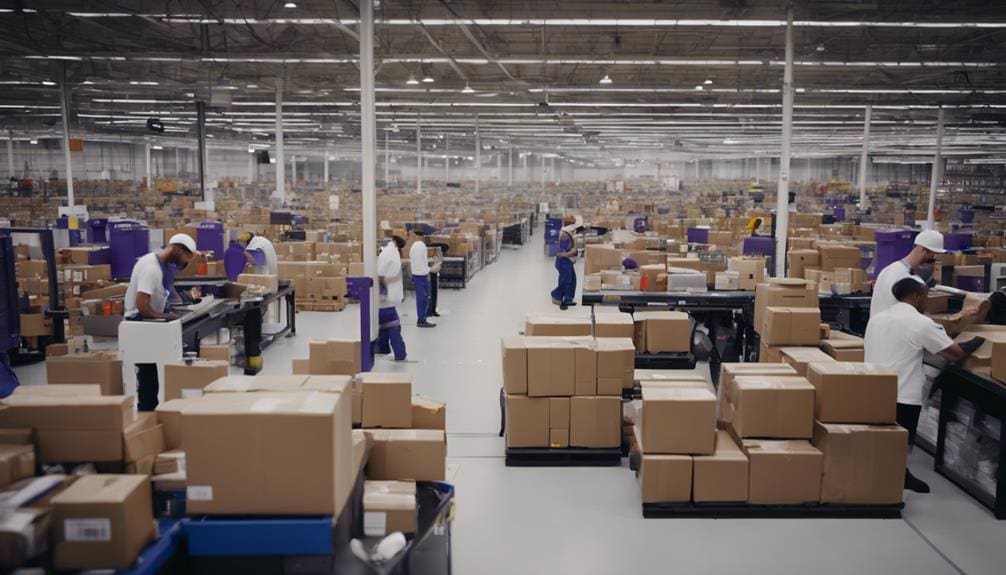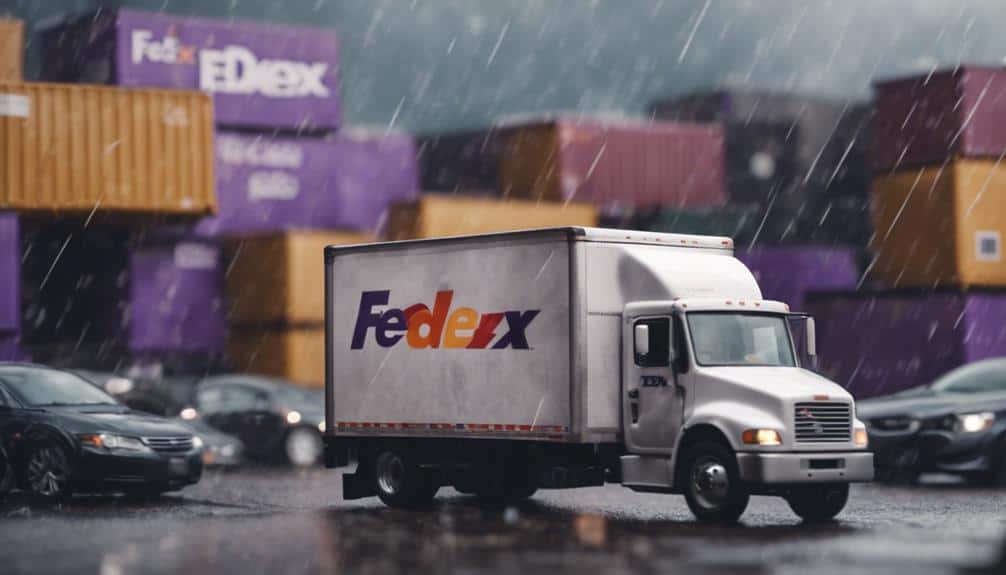FedEx delays are often caused by operational issues such as weather, volume overload, and clearance procedures. These setbacks, lasting 1-5 business days, impact millions of packages daily. Understanding and tracking shipments can alleviate concerns, as most packages eventually reach their destination. To resolve delays, consider alternative carriers and engage with customer service for updates. Monitoring closely and sharing experiences could lead to quicker resolutions. Recognizing the challenges and solutions surrounding FedEx delays is essential for managing expectations and ensuring a smoother delivery experience.
Key Takeaways
- Operational delays stem from weather, volume overload, and facility issues.
- Proactive customer communication mitigates frustrations and builds trust.
- Delays typically last 1-5 business days, depending on the situation.
- Utilizing alternative carriers can help expedite urgent shipments.
Operational Delay Definition and Causes

Analyzing the definition and underlying causes of FedEx operational delays sheds light on the intricacies of shipment disruptions within the FedEx shipping process.
Operational delays signify that packages are temporarily held within the FedEx system, often due to issues such as weather conditions, mechanical problems, or staffing shortages.
During these delays, shipment tracking becomes essential to provide customers with delivery assurance and transparency on the package's whereabouts.
These delays do not indicate permanent loss but rather a temporary setback in the delivery process.
Understanding the reasons behind operational delays enables proactive measures to mitigate disruptions and guarantee efficient resolution, enhancing overall customer satisfaction and trust in the FedEx shipping services.
Reasons Behind Delay Messages
Understanding the various factors contributing to delay messages in FedEx shipments is essential for effectively addressing and resolving delivery setbacks.
Customer communication plays a significant role in keeping recipients informed about the status of their packages. Transparency in shipping processes guarantees that customers are aware of potential delays caused by factors such as volume overload, weather disruptions, clearance procedures, local facility issues, and labeling errors.
By providing timely updates and explanations for delays, FedEx can enhance customer satisfaction and trust. Improving shipping transparency through detailed tracking information and proactive notifications can help manage customer expectations and minimize the impact of delays on recipient experience.
Effective communication strategies can mitigate frustrations and build confidence in FedEx's service reliability.
Duration and Impact of Delays

The duration and impact of operational delays in FedEx shipments play an essential role in evaluating the efficiency and reliability of the shipping process.
Understanding the typical duration of delays is vital for managing customer expectations. Domestic delays usually last 1-2 business days, while international delays may extend to 3-5 business days. Severe weather events or package issues could prolong these delays further.
Despite delays, most packages eventually reach their destination, emphasizing the importance of accurate package tracking and proactive customer service.
To mitigate the impact of delays, FedEx recommends monitoring tracking updates, verifying delivery addresses, and engaging with customer service for assistance.
Expected Package Arrival Scenarios
To manage customer expectations effectively during FedEx operational delays, understanding the scenarios for expected package arrival is essential for both customers and the shipping company.
When considering package tracking and delivery expectations, the following points provide insights into potential arrival scenarios:
- Tracking Updates: Regularly monitoring tracking status can offer indications of the package's progress and potential arrival time.
- System Rerouting: FedEx processes around 2 million packages daily and has systems in place to reroute shipments efficiently, ensuring eventual delivery.
- Backlog Resolution: After major delays, backlogs may extend delivery times, requiring additional days for normal operations to resume.
- Delivery Assurance: Packages not marked as lost in tracking status are likely to be delivered eventually, even in the presence of operational delays.
Resolving FedEx Operational Delays

How can customers effectively navigate and expedite the resolution of FedEx operational delays to guarantee timely package delivery?
When facing operational delays, customers can consider utilizing alternative carriers for urgent shipments to mitigate delays.
Understanding that operational delays are common in the shipping industry due to various factors, customers should keep track of their packages and stay informed about the status updates provided by FedEx.
By monitoring the situation closely and being proactive in seeking assistance from customer service, customers can enhance their overall experience and increase the chances of timely delivery.
Additionally, sharing experiences with FedEx delays on social media platforms can sometimes prompt quicker responses and resolutions.
Conclusion
In summary, maneuvering FedEx operational delays requires an all-encompassing understanding of the underlying causes and proactive strategies to mitigate their impact.
By analyzing the data-driven reasons behind delays and implementing solutions-oriented approaches, shippers and recipients can effectively manage their expectations and expedite the resolution process for smoother package deliveries.
Embracing this analytical mindset can lead to improved shipping experiences and enhanced customer satisfaction.

Oliver Postman was born and raised in a small town in the Midwest, where his fascination with postage began at an early age. At just six years old, he stumbled upon a box of old stamps in his grandfather’s attic, igniting a passion that would shape his life.

